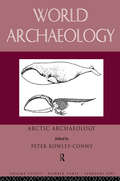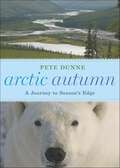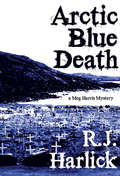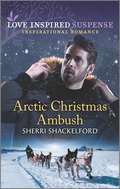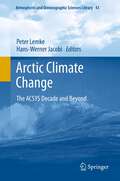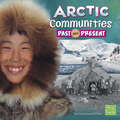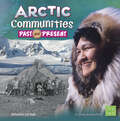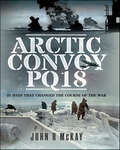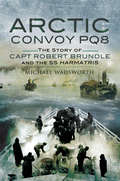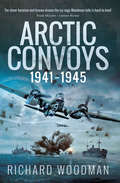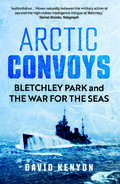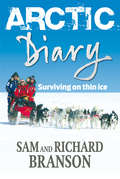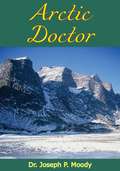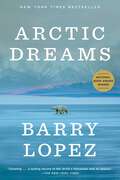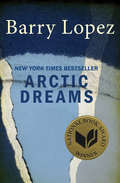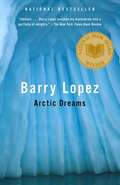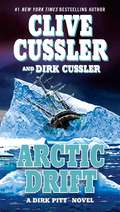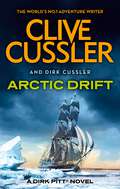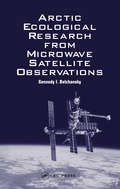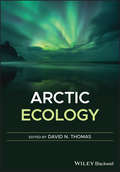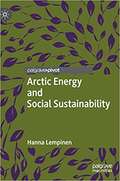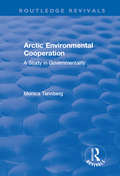- Table View
- List View
Arctic Archaeology
by Peter Rowley – ConwyExamining human occupation of the arctic and subarctic zones, irrespective of place and time, this book explores a wide variety of fascinating areas and inhabitants along several points in history. Beautifully illustrated, Arctic Archaeology is essential reading for all those curious about how organisms survived in this life threatening environment.
Arctic Autumn: A Journey to Season's Edge
by Pete DunneThe Arctic doesn't spring to mind when most people think about autumn. Yet in his continuing effort to invite readers' curiosity through unpredictability, Pete Dunne pairs the transitional season of autumn with this fragile environment in flux. The book begins on Bylot Island in Nunavut, Canada, at the retreating edge of the seasonal ice sheet, then moves to Alaska, where the needs of molting geese go head to head with society's need for oil. Then on to the Barren Lands of Canada and a search for the celebrated caribou herds that mean life and death for human and animal predators alike. A canoe trip down the John River is filled with memories, laughter, and contemplation. A caribou hunt with a professional trapper leads to a polemic on hunting. Dunne travels to an island in the Bering Sea, off the coast of Alaska, to look for rare birds and ponder the passionate nature of competitive bird listers. No trip to the Arctic would be complete without a trip to see polar bears, so Dunne and his wife visit Churchill, Manitoba, the polar bear capital of the world. These majestic but threatened creatures lead Dunne to think about his own life, our interactions with the natural world, and the importance of the Arctic, North America's last great wilderness.
Arctic Blast (The Executioner #288)
by Don PendletonWhile attempting to discover why a new anti-missile defense sysstem malfunctioned, Mack Bolan discovers a potential attack to destroy all of the American Southwest!
Arctic Blue Death: A Meg Harris Mystery
by R. J. HarlickShort-listed for the 2010 Arthur Ellis Award for Best Crime Novel The sparsely populated Arctic is no stranger to murder. The fourth in the Meg Harris series follows Meg’s adventures into the Candian Arctic as she searches for the truth about the disappearance of her father when she was a child. Many years ago, her father’s plane had gone missing in the Arctic and he was never seen again. What happened on that fateful flight? Thirty-six years later, her mother receives some strange Inuit drawings that suggest he might have survived. Intent on discovering the answers, no matter how painful, Meg travels to Iqaluit to find the artist and is sucked into the world of Inuit art forgery. Arctic Blue Death is not only a journey into Meg’s past and the events that helped shape the person she is today, but it’s also a journey into the land of the Inuit and the culture that has sustained them for thousands of years. Finalist for the Arthur Ellis Award for best crime novel. This is the fourth book in the Meg Harris Mystery series. The next book is A Green Place for Dying.
Arctic Christmas Ambush
by Sherri ShackelfordCaught between a killer on the looseand a deadly snowstorm…A man’s been murdered, and the only witness is Alaska State Trooper Shane Taylor’s ex, Kara Riley—a woman he’s sure has been keeping secrets. Now Shane and Kara are snowbound during a dangerous winter storm—with the killer! Shane’s convinced this has to be tied to Kara’s past, and he needs to find the truth…before they become a murderer’s next victims.From Harlequin Love Inspired Suspense: Courage. Danger. Faith.
Arctic Cinemas and the Documentary Ethos
by Anna Westerstahl StenportA collection of essays analyzing the representation of the Arctic region in documentary films.Beginning with Robert Flaherty’s Nanook of the North (1922), the majority of films that have been made in, about, and by filmmakers from the Arctic region have been documentary cinema. Focused on a hostile environment that few people visit, these documentaries have heavily shaped ideas about the contemporary global Far North. In Arctic Cinemas and the Documentary Ethos, contributors from a variety of scholarly and artistic backgrounds come together to provide a comprehensive study of Arctic documentary cinemas from a transnational perspective. This book offers a thorough analysis of the concept of the Arctic as it is represented in documentary filmmaking, while challenging the notion of “The Arctic” as a homogenous entity that obscures the environmental, historical, geographic, political, and cultural differences that characterize the region. By examining how the Arctic is imagined, understood, and appropriated in documentary work, the contributors argue that such films are key in contextualizing environmental, indigenous, political, cultural, sociological, and ethnographic understandings of the Arctic, from early cinema to the present. Understanding the role of these films becomes all the more urgent in the present day, as conversations around resource extraction, climate change, and sovereignty take center stage in the Arctic’s representation.“Highly recommended.” —Choice“A thorough exploration of the inexorable links between the circumpolar regions and historic and contemporary documentary filmmaking. It will b valuable to Arctic humanities specialists, particularly as a welcome addition to scholarship on visual depictions of the Arctic by authors such as Ann Fienup-Riordan, Richard Condon, Russell Potter, and Peter Geller, as well as Mackenzie and Westerstahl Steport’s earlier co-edited volume, Films on Ice. It will also be of use to anyone interested in ways of studying linkages between filmmaking, environments, and local and outsider communities.” —Sarah Pickman, Yale University, H-Environment, January 2020
Arctic Climate Change: The ACSYS Decade and Beyond (Atmospheric and Oceanographic Sciences Library #43)
by Hans-Werner Jacobi Peter LemkeThe Arctic is now experiencing some of the most rapid and severe climate change on earth. Over the next 100 years, climate change is expected to accelerate, contributing to major physical, ecological, social, and economic changes, many of which have already begun. Changes in arctic climate will also affect the rest of the world through increased global warming and rising sea levels. The volume addresses the following major topics: - Research results in observing aspects of the Arctic climate system and its processes across a range of time and space scales - Representation of cryospheric, atmospheric, and oceanic processes in models, including simulation of their interaction with coupled models - Our understanding of the role of the Arctic in the global climate system, its response to large-scale climate variations, and the processes involved.
Arctic Communities Past and Present (Who Lived Here? Ser.)
by Cindy Jenson-ElliottTo live in the Arctic, people have had to adapt to a freezing climate of ice and snow. Learn how Arctic communities have survived for thousands of years in this harsh environment. Discover how villagers find food in a land with few animals and plants. Examine how these communities are changing in a world of computers and global climate change.
Arctic Communities Past and Present (Who Lived Here?)
by Cindy Jenson-ElliottTo live in the Arctic, people have had to adapt to a freezing climate of ice and snow. Learn how Arctic communities have survived for thousands of years in this harsh environment. Discover how villagers find food in a land with few animals and plants. Examine how these communities are changing in a world of computers and global climate change.
Arctic Convoy PQ18: 25 Days That Changed the Course of the War
by John R. McKay"Extensively researched, this book is a real page-turner. It's written in a narrative style that puts the reader beside its protagonists on both sides, describing their probable thoughts and actions in the face of events." — PowerShips Magazine This superbly researched book tells the story of one of the most significant maritime operations of the Second World War. The importance of the Arctic convoys providing the Soviets with the necessary equipment needed to win the war on the Eastern Front has too often been underestimated. This book puts that right. Following PQ17, the worst Allied maritime disaster of the Second World War, it was imperative that PQ18 got through. So when the convoy left Loch Ewe on 2 September 1942 the stakes could not have been higher. The Battle of Stalingrad was hanging in the balance. Had the convoy suffered unacceptable shipping and war supply losses, the Arctic route would have had to be suspended with potentially war-changing consequences not just for the Soviets but the whole Allied war effort. Consequently, as this work vividly describes, it was both the most heavily defended and the most heavily attacked convoy of the whole war. The Author draws on contemporaneous accounts of the combatants from both sides including U-boat crews, airmen and, of course, the crews of the warships and merchantmen. Offering newly discovered facts about the convoy’s turbulent passage, this book is a valuable addition to the history of the campaign which will appeal to historians and laymen alike.
Arctic Convoy PQ8: The Story of Capt Robert Brundle and the SS Harmatris
by Michael WadsworthWhen Robert Brundle took the SS Harmatris to Russia with Convoy PQ8 he was 47 years of age. Both ship and master were veterans and had already sailed in convoys across the North Atlantic and to South Africa. The 5,395 ton coal fired ship, laden with 8,000 tons of armaments originally set sail on 27 November 1941 to join convoy PQ6 but encountered a fierce storm in which a lorry broke free in the hold and started a fierce blaze below decks. Despite valiant attempts to extinguish the fire the Harmatris was forced to return to Glasgow for repair. Having discharged its cargo, examined and repaired the holds, it restowed and finally put to sea again on 26 December. She was now to join PQ8 and Brundle was elected Convoy Commodore. Two minesweepers, a cruiser and two destroyers escorted the eight merchant vessels.On 8 January the convoy left Reykjavik bound for Murmansk. Harmatris was struck by two torpedoes in No 1 hold which caused flooding. A third torpedo struck her a few hours later and the crew evacuated to HMS Speedwell in attendance. A volunteer crew reboarded and Speedwell took the wounded ship in tow. During the night the same U Boat that had struck Harmatris sunk the destroyer Matabele with the loss of all but two of her crew. A tug eventually replaced Speedwell and the entire crew now returned to their still stricken vessel. On 18 January the ships were twice attacked by low flying Heinkels. The stricken Harmatris finally berthed in Murmansk at 0800 on 20 January. Once unloaded the battered ship entered dry dock on 10 February. The damage was considerable. In a temperature of 40 degrees below zero the crew set about the repairs. It was difficult to locate engine parts and local labor was scarce.During the following months the crew continued to work on the ship, food was scarce and the port was frequently bombed by the Luftwaffe. Several ships close to Harmatris were sunk. It was 21 July when the ship finally left for Archangel. She took aboard a cargo of 3,000 tons of steel pipes and on 13 September she was instructed to join a convoy of 20 ships, QP14 for her return voyage. On 19 September the minesweeper HMS Leda, steaming close by Harmartris, was torpedoed. The convoy was under almost continuous U Boat attack and suffered six losses. As a result of his heroic efforts to preserve his ship and crew Captain Brundle was awarded the OBE and the Lloyds War Medal. He died in 1960 at the age of 66.
Arctic Convoys, 1941–1945
by Richard WoodmanThe story of Allied merchant ships and crews who braved the frigid far north to extend a lifeline to Russia, filled with &“sheer heroism and brazen drama&” (Literary Review). During the last four years of the Second World War, the Western Allies secured Russian defenses against Germany by supplying vital food and arms. The plight of those in Murmansk and Archangel who benefited is now well known, but few are aware of the courage, determination, and sacrifice of Allied merchant ships, which withstood unremitting U-boat attacks and aerial bombardment to maintain the lifeline to Russia. In the storms, fog, and numbing cold of the Arctic, where the sinking of a ten thousand–ton freighter was equal to a land battle in terms of destruction, the losses sustained were huge. Told from the perspective of their crews, this is the inspiring story of the long-suffering merchant ships without which Russia would almost certainly have fallen to Nazi Germany.
Arctic Convoys: Bletchley Park and the War for the Seas
by David KenyonAn incisive account of the Arctic convoys, and the essential role Bletchley Park and Special Intelligence played in Allied success Between 1941 and 1945, more than eight hundred shiploads of supplies were delivered to the Soviet Union protected by allied naval forces. Each journey was a battle against the elements, with turbulent seas, extreme cold, and the constant dread of torpedoes. These Arctic convoys have been mythologized as defenseless vessels at the mercy of deadly U-boats—but was this really the case? David Kenyon explores the story of the war in the Arctic, revealing that the contest was more evenly balanced that previously thought. Battles included major ship engagements, aircraft carriers, and combat between surface ships. Amid this wide range of forces, Bletchley Park’s Naval Section played a decisive role in Arctic operations, with both sides relying heavily on Signals Intelligence to intercept and break each other’s codes. Kenyon presents a vivid picture of the Arctic theater of war, unearthing the full-scale campaign for naval supremacy in northern waters.
Arctic Diary: Surviving on thin ice
by Richard Branson Sam BransonIt's hardly a surprise to discover that Sam Branson has a love of adventure and a real concern about our future in a world where the climate is changing rapidly. Journeying into the heart of the Arctic wilderness with his father and a film crew, Sam explores the changing landscape and the lives of the native Inuit people who have survived in a relentlessly inhospitable environment for 5000 years.Sleeping on frozen seas and encountering majestic polar bears, Sam and his father embark together on a winter expedition which Sam must ultimately complete on his own, finding new depths of resilience and courage in a formidable and breathtaking landscape.
Arctic Doctor
by Dr Joseph P. MoodyArctic Doctor is an account of the true adventures of Joe Moody, the heroic young medical doctor whose practice covered 600,000 square miles of Canada’s East Arctic. Headquartered at Chesterfield Inlet on the west coast of Hudson Bay, Joe Moody made “routine” calls to his 2,000 Eskimo patients that required to take perilous trips by aircraft, dog sled, and canoe; to direct complicated surgery by telephone; and to confront Eskimo practices of infanticide and the “assisted suicide” of the age.Dr. Moody’s book is an exciting and suspenseful account of his years in the East Arctic—years of courageous effort on behalf of his profession, years devoted to scientific and human observation of the most fruitful kind, and years of heady adventure rarely matched in the annals of northland fiction.
Arctic Dreams
by Barry LopezWinner of the National Book Award This bestselling, groundbreaking exploration of the Far North is a classic of natural history, anthropology, and travel writing.The Arctic is a perilous place. Only a few species of wild animals can survive its harsh climate. In this modern classic, Barry Lopez explores the many-faceted wonders of the Far North: its strangely stunted forests, its mesmerizing aurora borealis, its frozen seas. Musk oxen, polar bears, narwhal, and other exotic beasts of the region come alive through Lopez&’s passionate and nuanced observations. And, as he examines the history and culture of its indigenous communities, along with parallel narratives of intrepid, often underprepared and subsequently doomed polar explorers, Lopez drives to the heart of why the austere and formidable Arctic is also a constant source of breathtaking beauty, mystery, and wonder. Written in prose as pure as the land it describes, Arctic Dreams is a timeless mediation on the ability of the landscape to shape our dreams and to haunt our imaginations.
Arctic Dreams: Imagination And Desire In A Northern Landscape (Read-On)
by Barry LopezThis New York Times–bestselling exploration of the Arctic, a National Book Award winner, is &“one of the finest books ever written about the far North&” (Publishers Weekly). &“The nation&’s premier nature writer&” travels to a landscape at once barren and beautiful, perilous and alluring, austere yet teeming with vibrant life, and shot through with human history (San Francisco Chronicle). The Arctic has for centuries been a destination for the most ambitious explorers—a place of dreams, fears, and awe-inspiring spectacle. This &“dazzling&” account by the author of Of Wolves and Men takes readers on a breathtaking journey into the heart of one of the world&’s last frontiers (The New York Times). Based on Barry Lopez&’s years spent traveling the Arctic regions in the company of Eskimo hunting parties and scientific expeditions alike, Arctic Dreams investigates the unique terrain of the human mind, thrown into relief against the vastness of the tundra and the frozen ocean. Eye-opening and profoundly moving, it is a magnificent appreciation of how wilderness challenges and inspires us. Renowned environmentalist and author of Desert Solitaire Edward Abbey has called Arctic Dreams &“a splendid book . . . by a man who is both a first-rate writer and an uncompromising defender of the wild country and its native inhabitants&”—and the New Yorker hails it as a &“landmark&” work of travel writing. A vivid, thoughtful, and atmospheric read, it has earned multiple prizes, including the National Book Award, the Christopher Medal, the Oregon Book Award, and a nomination for the National Book Critics Circle Award. This ebook features an illustrated biography of Barry Lopez including rare images and never-before-seen documents from the author&’s personal collection.
Arctic Dreams: Imagination and Desire in a Northern Landscape
by Barry Holstun LopezThis National Book Award winner examines the Far North - its terrain, wildlife, and history of the Eskimo natives and intrepid explorers who arrived on its icy shores. What turns this compendium of biology, anthropology and history into a breathtaking study of profound originality is Lopez's unique meditation on how the landscape can shape our imagination, desires and dreams.
Arctic Drift (Dirk Pitt #20)
by Clive Cussler Dirk CusslerA foundered Victorian ship looking for the fabled Northwest Passage holds a secret in its icy grave... <P><P>When Dirk Pitt of NUMA is almost blown to pieces in a lab explosion, he suspects sabotage. The lab in question belongs to a scientist hoping to use a rare mineral to combat greenhouse gases - but who would want to destroy our one chance to save the planet? <P><P>However, there are those who will do anything to control such a valuable prize. Pitt's investigations take him to the Arctic in search of a clue to the origins of this precious mineral. There he and NUMAr colleague Al Giordino must battle for survival against the hostile elements and evil megalomaniac who is about to plunge the North American continent into war... <P><P> Artic Drift is a white-knuckle ride of a novel that once picked up you won't want to put it down.
Arctic Drift: Dirk Pitt #20 (Dirk Pitt Adventures #20)
by Clive Cussler Dirk CusslerA foundered Victorian ship looking for the fabled Northwest Passage holds a secret in its icy grave . . .When Dirk Pitt of NUMA is almost blown to pieces in a lab explosion, he suspects sabotage. The lab in question belongs to a scientist hoping to use a rare mineral to combat greenhouse gases - but who would want to destroy our one chance to save the planet?But there are those who will do anything to control such a valuable prize. Pitt's investigations take him to the Arctic in search of a clue to the origins of this precious mineral. There he and NUMA colleague Al Giordino must battle for survival against the hostile elements and an evil megalomaniac who is about to plunge the North American continent into war . . .Arctic Drift is a white-knuckle ride of a novel that sees Clive Cussler's greatest hero, Dirk Pitt, fighting his enemies in the cruel Arctic.Praise for Clive Cussler'Clive Cussler is hard to beat' Daily Mail'Clive Cussler is the guy I read' Tom Clancy'The Adventure King' Daily Express
Arctic Drift: Dirk Pitt #20 (Dirk Pitt Adventures #20)
by Clive Cussler Dirk CusslerA foundered Victorian ship looking for the fabled Northwest Passage holds a secret in its icy grave . . .When Dirk Pitt of NUMA is almost blown to pieces in a lab explosion, he suspects sabotage. The lab in question belongs to a scientist hoping to use a rare mineral to combat greenhouse gases - but who would want to destroy our one chance to save the planet?But there are those who will do anything to control such a valuable prize. Pitt's investigations take him to the Arctic in search of a clue to the origins of this precious mineral. There he and NUMA colleague Al Giordino must battle for survival against the hostile elements and an evil megalomaniac who is about to plunge the North American continent into war . . .Arctic Drift is a white-knuckle ride of a novel that sees Clive Cussler's greatest hero, Dirk Pitt, fighting his enemies in the cruel Arctic.Praise for Clive Cussler'Clive Cussler is hard to beat' Daily Mail'Clive Cussler is the guy I read' Tom Clancy'The Adventure King' Daily Express
Arctic Ecological Research from Microwave Satellite Observations
by Gennady I. BelchanskyActive (imaging radar) and passive (radiometer) microwave systems are increasingly used for Arctic ecological research. Unfortunately, until now ecologists interested in remote sensing often lacked access to the full suite of physical and analytical techniques of microwave systems, data processing, and ecological applications because a suitable ref
Arctic Ecology
by David N. ThomasThe Arctic is often portrayed as being isolated, but the reality is that the connectivity with the rest of the planet is huge, be it through weather patterns, global ocean circulation, and large-scale migration patterns to name but a few. There is a huge amount of public interest in the ‘changing Arctic’, especially in terms of the rapid changes taking place in ecosystems and exploitation of resources. There can be no doubt that the Arctic is at the forefront of the international environmental science agenda, both from a scientific aspect, and also from a policy/environmental management perspective. This book aims to stimulate a wide audience to think about the Arctic by highlighting the remarkable breadth of what it means to study its ecology. Arctic Ecology seeks to systematically introduce the diverse array of ecologies within the Arctic region. As the Arctic rapidly changes, understanding the fundamental ecology underpinning the Arctic is paramount to understanding the consequences of what such change will inevitably bring about. Arctic Ecology is designed to provide graduate students of environmental science, ecology and climate change with a source where Arctic ecology is addressed specifically, with issues due to climate change clearly discussed. It will also be of use to policy-makers, researchers and international agencies who are focusing on ecological issues and effects of global climate change in the Arctic. About the Editor David N. Thomas is Professor of Arctic Ecosystem Research in the Faculty of Biological and Environmental Sciences, University of Helsinki. Previously he spent 24 years in the School of Ocean Sciences, Bangor University, Wales. He studies marine systems, with a particular emphasis on sea ice and land-coast interactions in the Arctic and Southern Oceans as well as the Baltic Sea. He also edited a related book: Sea Ice, 3rd Edition (2017), which is also published by Wiley-Blackwell.
Arctic Energy and Social Sustainability
by Hanna Lempinen<p>In recent years the Arctic has become the focus of political, popular and scholarly debates around the future of our world’s Energy. Increasing consumption, dwindling reserves, climate warming and developing technologies are expected to push energy-related activities ever further into the previously inaccessible north. Within this framework, energy in the Arctic is predominantly understood as synonymous with oil and gas production for international exports; meanwhile, any social sustainability concerns associated with energy-related developments remain largely neglected or reduced to regional socioeconomic concerns. <p>Lempinen adopts an alternative approach, exploring how energy and its societal aspects are defined and debated in the context of the circumpolar north. Combining an in-depth conceptual discussion on energy and the social dimension of sustainability with an empirical focus on the scientific and political “truths” produced about energy and society in the Arctic energyscape, this book is an enlightening read for students, scholars and professionals interested in issues related to energy and society in the Arctic or beyond.</p>
Arctic Environmental Cooperation: A Study in Governmentality (Routledge Revivals Ser.)
by Monica TennbergThis title was first published in 2000: The book analyses the development of arctic environmental cooperation since the late 1980s until the establishment of the Arctic Council in 1996. The study is based on the discourse analysis of statement, documents and interviews by the different actors in the cooperation. In this book, the problem of the environment is seen as a problem of order: it is a problem of ordering relations among related actors, of ordering priorities of action and of ordering relations between different institutional arrangements locally, regionally and internally. Three discourses were found in the cooperation: discourses of sovereignty, knowledge and development. In the discourse of sovereignty, the development of relations between state and indigenous peoples in terms of international environmental cooperation is central. In the discourse of knowledge, the different forms of knowledge and the role of different producers of knowledge in cooperation has been discussed. The discourse of development focuses on the idea of sustainable development and its applications in defining the future of the Circumpolar North and the activities of the Arctic Council. The arctic cooperation can be understood as a regional effort to make an order of sustainability into practice.
